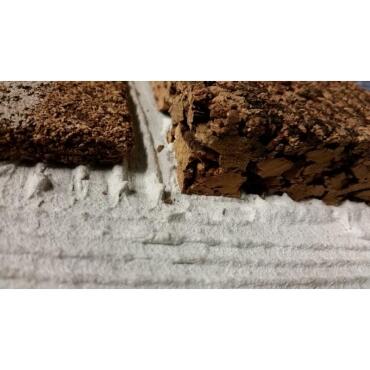Cork is a natural product obtained by shelling cork oak. The trees take no harm from this, so properly peeled cork is also grds. FSC certified.
Even high-tech products from the construction industry can not match some of the properties of roll cork. Due to its structure with millions of small air cells, its nano surface and the unique suberin resins, Rollenkork makes an outstanding figure in the test of impact sound insulation, thermal insulation and walking comfort.
Features roll cork
Rollenkork as impact sound insulation and underlay
Due to its unique properties, the material has very good values for footfall and footfall sound insulation values. Basically, a higher strength achieves an improved insulation effect. We recommend you to purchase at least 4mm thick cork for this function, but we recommend you to speak to our application engineering about the right footfall pad. Non-binding and free!
Roll cork as a comfort factor: Improves walking comfort
Roller cork can significantly increase walking comfort. Please ask our professionals - we will help you to find the right material for the right environment.
Technical and physical properties of roll cork
high elasticity
pollutant-free
Antistatic
heat and sound insulating
breathable
balances small bumps in the ground
Free of solvents and pollutants
Excellent pressure stability with up to 7t / m²
Application areas
Roller cork is particularly suitable for laying under floating laid parquet floor, laminate floor or cork floors. However, except as a base under floors roll cork can also be used as a heat-insulating wallpaper. This saves heating costs and also improves the room climate.
It is also often found in model making, especially in model railway construction, as well as in plant construction.
Basically you should not use roll cork yourself as a floor covering. However, you are welcome to contact us, and we have developed interesting solutions for this as well.
application Notes
Lay out and acclimatise
Most of our products are - as the name suggests - delivered rolled. As a natural product, roll cork should be treated as such, that is: give the material 12 - 24 hours to acclimate to the indoor climate and temperature before laying the material firmly. For this you can put the roll upright and remove the packaging.
Note that roll cork rolls up by itself. This behavior disappears after a loose design within a few hours. If this is too complicated for you, you can fall back on our already cut plates.
Before the installation
BEFORE laying, make sure that the floor is free of grease, moisture and dust for best results.
equipment
Roll cork can be cut and processed with a commercial cutter, special tools are not required. As a "ruler" to cut you can, for. use a setting bar.
If you do not want to be able to loosely lay your underlay, we have numerous cork adhesives on offer. Again, you should contact us shortly, so we can pick out the right glue for your substrate and your flooring.
Use roll cork 2mm
This rather thin roller cork compensates for bumps and increases walking comfort. If you are particularly concerned with footfall sound insulation, it may be better to use a higher thickness - contact us if you are not sure.
The material is also particularly favorable for model making, for example as a plate support for model trains. Due to the antistatic properties, dust is a minor problem and trains slide quieter over the system.
Use reel cork 4mm
Excellent as impact sound insulation and insulation.
Use reel cork 8 - 10 mm
From 8mm thickness, roll cork is particularly suitable for reinforced acoustic and thermal insulation, but can also be used as a pin board. The high-density material has particularly strong values in all areas.
large amounts
If you are interested in purchasing large quantities, you can contact us for an individual offer. Note that we do not offer this option for single or small purchase!



















